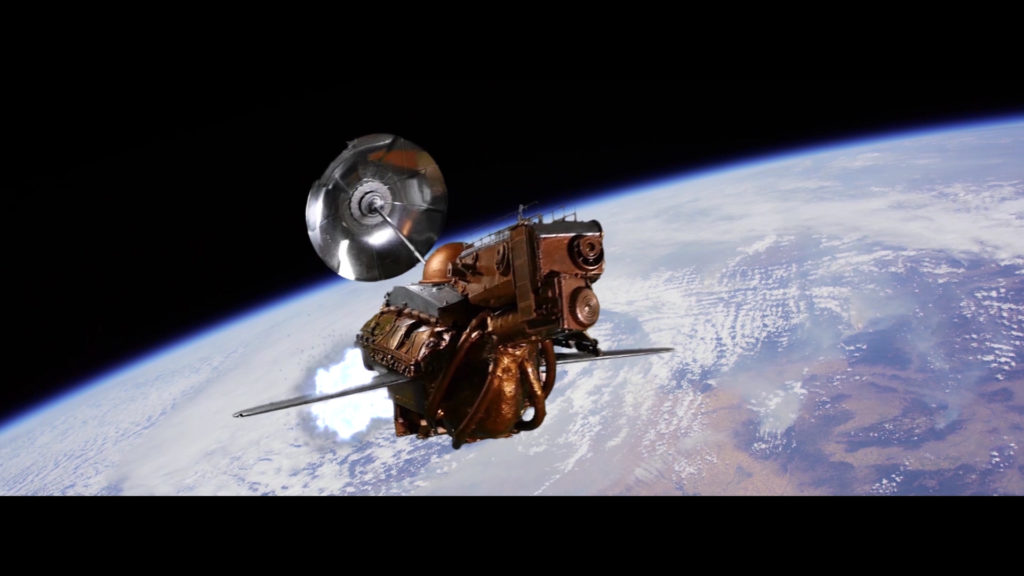About the Project
Space 1889 – The Secret of Phobos started as a Kickstarter project and quickly became one of the absolute highlights in the Pen & Paper community. Within a few days the film collected its budget and was able to go into production. The story of Space 1889 takes place in a steampunk-influenced parallel universe in which the colonization of Mars and its inhabitants has come true.
In this world, Wilhelmina Armstrong and her crew are trying to survive by all means as adventurers and bounty hunters, becoming involved in a conspiracy that could destroy the whole planet.
Concept

When director Nico Mendrek and I talked the first time about the music concept, it was clear to us that we both wanted to emphasize that the film is a classic adventure, inspired by the old Indiana Jones and Alain Quartermain movies.
In a first concept for the Main Theme, I used many organs, metallic percussion and Victorian instruments to develop a modern, unique feel for the setting and the world. I wanted to give the Steampunk atmosphere a sound.
Although we both liked the sound, it didn’t match the characters, the story and mood of the film. Even though the steampunk setting offered itself for such an approach, we realized that we should use the music more to emphasize the adventure aspect of the movie.
I decided to completely discard the first concept and focus on the characters and their story rather than on the setting. The main theme should feel easy, capture the wit and adventure, and should go more in the direction of an 80s movie sound-wise.
Reminiscent of the great themes of John Williams and Jerry Goldsmith, the new theme was based entirely on classical orchestral sounds, with the motif for Wilhelmina being a light and fun string rhythm, accompanied by flutes.
Already at the first screentest the theme harmonized perfectly with the heroes and we had found our sound concept.
With this step it became clear that we would need many motifs and themes for the rest of the soundtrack. The theme was so special that we would need something different for other situations and characters. While Wilhelmina and her adventures now had a motive and were chosen to be the Main Theme, I developed new themes for the most important aspects of the film.
The Martian Theme

This theme was to represent the second most important topic in the story and was intended to emphasize the Martians, their culture and the mysteries surrounding them. To do this, I used a combination of deep choirs, arranged in a bit of a unique way to prevent it from sounding too sacral and classic. They were accompanied by mostly floating, atonal soundscapes more reminiscent of contemporary music. This helped to bring out the alieness of the Martian culture as well as the threat posed by the artifacts. In addition, I developed from these components a motif that should stand for the dark, Martian cult (the opponents in this film) so that it could be a bit more menacing.
The Romantic Theme
In order to emphasize the story of the Martian princess and, above all, the tragedy behind her story, I wanted to develop a particularly fragile theme for her. I wanted the melody to be slightly similar to the Martian theme but I wanted her to be more relatable and human.
The Action Theme
One thing I learned from many Alan Silvestri soundtracks: a well-established action theme still adds the special spice, especially to the finale of a movie. Since the soundtrack to this film was already very motive-guided, I also wanted to have a theme, which could shine especially in the great heroic moments.
Other motives

The second villain in command, Basil Zacharov, got a shady, but less threatening motif to distinguish between him and the big villains of the dark cult. The dinosaur got his own motif, too (and yeah, I couldn’t resist to cite something from Jurassic Park), as well as the Martian henchman and the famous bounty hunter .
Action scenes need their own theme
Several action scenes got their own motifs (a technique I learned from John Williams’s “The Empire Strikes Back” soundtrack) to strengthen the flow of the scenes, do justice to their own character and their own story arc and also make sure I wouldn’t overuse the other themes. I made sure that both, the mood and the setting of the scene were taken into account
The scene where our heroes finally fly to Phobos had a very special rhythm and I felt it needed something different than the Main Theme or the Action Theme. It needed to be much more heavier and slower while still having the feeling of haste in it

The Escape from the Starport was quite the opposite of this. It was about a secondary character and the Main Theme didn’t fit for him, and also, it was much more funny than all the other action scenes in this movie, so I decided to break out from the orchestral mood and go more into something that fits the timeframe
The finale is of course something completely different. Here, all the storyarks get completed and so this is the moment, when also all the Themes are fully developed, or even find their final form (like the theme for the bad guys). There were many reprises of the known themes that bring meaning and gravitas to what is happening on the screen

